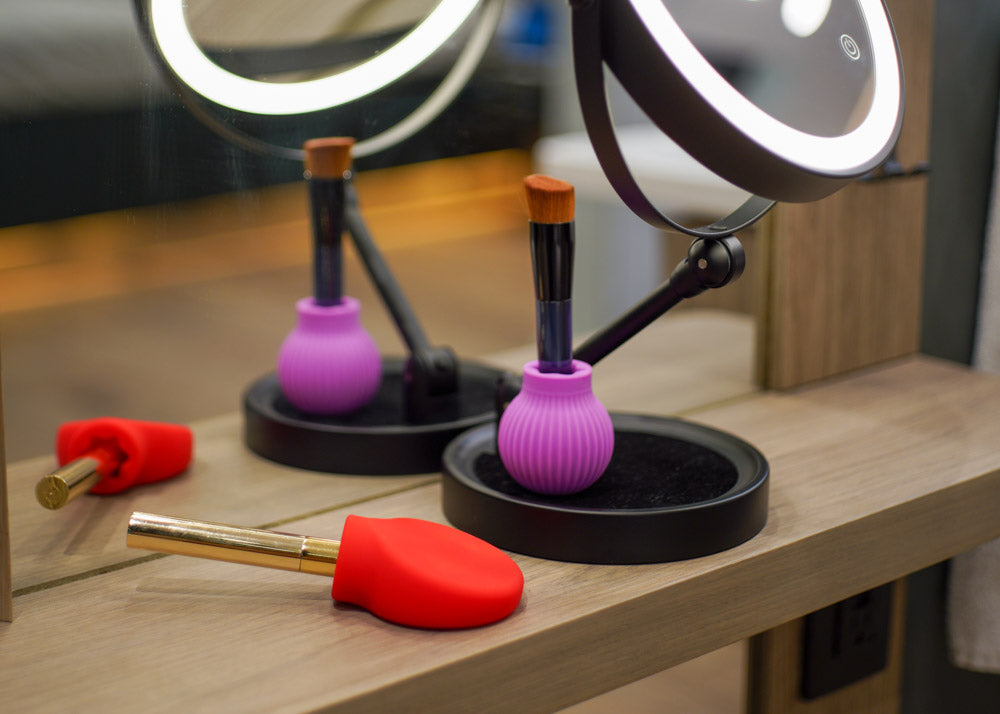Designing a Shower Stool
Q&A About How we Designed the Lotic Shower Seat
Two years of work went into the designing of our Lotic Shower Seat! Our founder and industrial designer, Kaly, answers some questions about the design process.

What inspired you to start designing Lotic?
Back in 2015 at Willow & Stump Design Co. we made a custom teak bathroom step stool for Vancouver based Port + Quarter Interior Design. Not only was it a fun project, but it opened our eyes to the lack of truly functional and stylish bathroom products on the market.

Stool Design by Port + Quarter Interiors, photography by Working Title Graphic Design
A few years later my business partner Bram and I were going back and forth about ideas for new furniture designs. Bram’s sister Rachel, an Occupational Therapist, mentioned the issue of finding a nice shower stool for clients. We decided to combine our love of functional design and modern styling to make a new product.
Where did you begin the process?
With research!
We spent months learning about the current shower stools on the market, how they fit into bathtubs and showers, as well as their features including adjustability, materials, and ergonomics.
We also learned about how people actually use these products from Occupational Therapists, Gerontologists, Interior Designers, seniors themselves, and Aging-in-Place Specialists. This research is how the idea for Capella Design was born: We realized stylish assistive product design had a potential for its own company (but more on that another time).
How did you choose the materials?
Early on we knew we wanted to explore a design with modern materials (not hospital-looking plastic and cheap metal parts). We wanted materials that would allow us to manufacture locally, and of course we wanted options that were sustainable.
We’d worked with solid surface in the past (most commonly used for countertops) and thought it would be great for a shower stool. Solid surface is non-porous / easy to clean, repairable, and comes in so many modern colors. It has a variety of sustainability certifications and no VOC emissions.

HIMACS Solid Surface in Terrazzo

We really wanted to use wood for this project but the best wood for the shower is teak, and even “sustainably sourced” teak creates demand that is hurting the environment. Additionally, teak shower stools require regular maintenance which might affect how long our clients use the product (we hope you never throw it away).
We were so excited when we discovered NewTech Wood’s composite products. They create dimensional pieces that look like teak wood, but are made from 95% recycled materials including recycled plastic bottles and wood fibers. Unlike wood they never need to be refinished and are easy to clean!
What was the rest of the design process like?
Once we decided on the two main materials as a design limitation, Bram and I opened our sketchbooks. We went back and forth sketching and creating 3D models and renders of different ideas.
When working together Bram and I have always made simple prototypes early in the process to test our ideas. We created many scale models out of everything from cardboard, plywood, to the final materials. Scale models let us test features like stability, the handholds, the angle of the seat, and so much more.
We released the initial version in fall 2021 under Willow & Stump and after some user and expert feedback we adjusted the design to the version of the stool available through Capella Design today. We spent two years getting the Lotic Shower Seat just right!

Top Left: Early render of the shower stool concept. Bottom Left: Plywood mockup of the final side design. Right: First version of the shower stool
What was the most exciting part of designing the shower stool?
I really appreciate the experts and users who shared their knowledge about accessible products. The best part was their excitement for new designs that don’t look and feel like they belong in a hospital.
I learned so much about assistive and accessible design while working on this shower stool. I can't wait to continue designing assistive furniture that empowers people, looks great in their modern homes, and is made sustainably.



